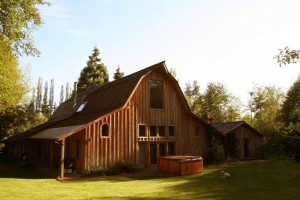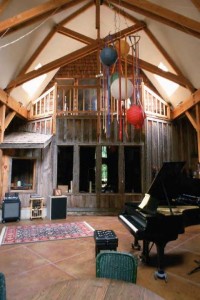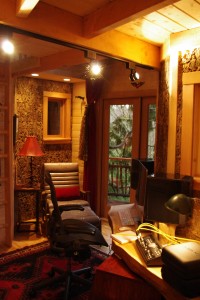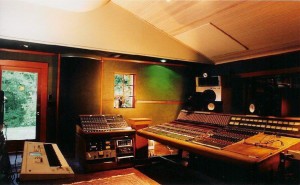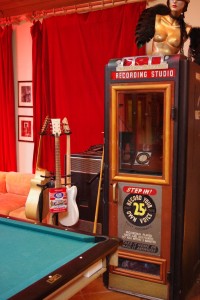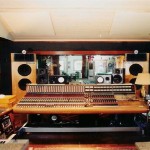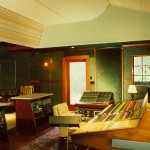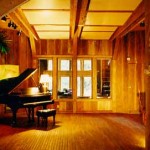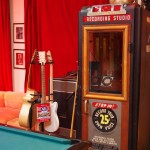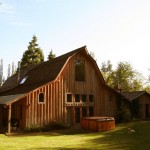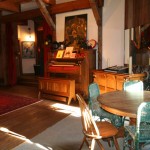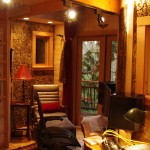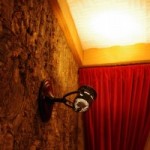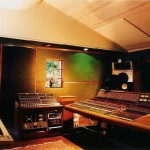Recording Retreats: Bear Creek Studio in Woodinville, WA
Drive thirty minutes North of Seattle to Woodinville, and along the quiet, two-lane Maltby Road you’ll find Bear Creek Studio.
Or, maybe you won’t at first. The small dirt turnoff that leads up to the studio isn’t clearly marked. Firs and cedars stretch to the sky on and around the property, keeping it tucked away from the rest of the world.
Outside, you can hear the studio’s namesake purring softly in the background, but a small hand-made sign is the only official marking to let you know you’re here.
Looking at the old converted barn next to Bear Creek, you might not guess that inside, two generations of The Hadlock family have hosted everyone from James Brown to Eric Clapton, Soundgarden, and the Foo Fighters.
In 1975, Joe and Manny Hadlock had a thriving commercial music business. What they didn’t have was enough available time at studios for all the work they had been commissioned to do.
The husband-and-wife team had been working together almost since the day they met in college in 1967, with Manny managing Joe’s band at first, and designing costumes for them. When Joe won a free recording session in a local battle of the bands and proved to be a natural in the studio, Manny began hustling up commercial work for them from advertising agencies:
“I was a really good salesman. If there was a job in Seattle that paid for music, I got it,” says Manny on a Skype call from a village in Mexico where she and Joe spend part of the year.
“Before Bear Creek, we were booking as much time as we could at every studio,” Joe adds. “Once we got the Rainier Beer account, where we would make 10 TV commercials and 15 radio commercials every February, we realized we needed a place.”
They found Bear Creek, an abandoned 40-acre farm with a hand-painted “For Sale” sign out front. “The house was trashed, but it was a solid old 1920s farmhouse,” says Manny. “There was a huge old red barn with the creek out in the back. We just said ‘that’s it, that’s our recording studio’.”
A Different Kind of Environment
“It was really fun,” Manny says of Bear Creek’s early construction. “People spent the night —several nights—and we took down all the wood [from the barn] and it was like this work party where we would do these barn dances at night and have these big bonfires. We had about 20 people who helped turn the studio around.”
Those friends became some of the studio’s first clients in 1977. Since then, Joe, Manny, their daughter Ann, and their son Ryan—now the head producer at Bear Creek— have cemented the studio’s reputation by treating all their clients in the same manner: As friends, collaborators, and welcomed houseguests.
During the recording process, that means following the muse wherever it leads, sometimes even out into nature. Joe recalls a session where he went outside to record shotgun blasts to mix in with a snare drum, and another that Ryan did with The Black Heart Procession, in which they placed a Leslie speaker in the middle of the woods and mic’d it from a few hundred feet away.
Sometimes, nature follows them back into the studio:
“In spring, the frogs are so loud they can get into the studio on a quiet guitar recording. The frogs ended up on a lot of people’s records. I think the frogs made it onto Alice In Chains and some commercials. We called it ‘frog leakage’.”
Outside of the studio, The Hadlocks provide a home away from home.
“A lot of the groups that we worked with then, and that Ryan works with now, tour and play 200 nights a year,” says Joe. “When it’s time to make a record, they don’t want to go somewhere and stay in a hotel, which is what they’ve been doing the last ten months. They can come here and have it be like a home. A hardworking touring band needs to recover from being on the road, and I think Bear Creek continues to be a great place to do that.”
“If a band came in for a week or a month, we would have them over for dinner. They were our friends. If it weren’t for them, we’d have been lonely,” Manny adds. “To us the most important thing was making a space that was very creative, that somebody would feel comfortable in, and to not have a clock. A clock ticking every second makes you feel uncomfortable.”
In the control room of Bear Creek, you’ll find a Neve BCM-10, and a 56-channel Trident TSM console from London, once used on tracks like Rod Stewart’s “Maggie Mae”. A Steinway Grand B sits in “The Wood Room”. The 2” Studer tape machine can be brought out at a moment’s notice to track drums and bass before dumping them into ProTools.
In 45 minutes of talking with The Hadlocks about what makes Bear Creek special, we almost never discuss the gear, though. Manny only makes a point to mention one technical aspect of the studio: “We wanted one big room so that that would be the only thing—the one important thing,” she says of the cathedral-like space inside the barn.
The Studio In the Trees
The Hadlocks have expanded Bear Creek intermittently throughout the years. In the early 90s, they nearly doubled the size of their main room to accommodate the sound of the grunge bands that came in regularly. Bear Creek’s most recent addition is its most ambitious and unusual yet: A small treehouse studio twenty feet off the ground.
The studio in the trees is a collaboration between the Bear Creek family and the makers of the Animal Planet television show “Treehouse Masters”. Show host Pete Nelson and his crew put the studio together in a matter of weeks with help in the design from The Hadlocks—including Joe and Manny’s daughter Ann, whose art adorns the studio walls.
Nelson built the treehouse studio into a small grove of western redcedars maybe twenty yards from the main building. Although it boasts two stories, the studio most likely can’t fit a full band with drumkit. Joe was initially hesitant of the idea, but warmed to it once he saw the studio’s other potential:
“It’s ideal for overdubs, vocals, and guitar stuff, or as a writing studio where someone can have some space of their own. I think there also might be some power in that circle of fifty year-old cedar trees.”
Studio manager Jerry Streeter—who was nice enough to show me the treehouse while the elder Hadlocks were down in Mexico and Ryan was off producing a band in Poland—believes the treehouse will become just another practical part of Bear Creek in time. It’s the perfect size for solo singer-songwriters and smaller folk outfits, the types of artists that already make their way to Bear Creek regularly. “You could also record guitar overdubs up there and fly them into a session while the rest of the band works in the big room”.
Where does the treehouse studio get power from?
Jerry points to a power source the treehouse shares with the nearby hot tub. Yes, that’s right, hot tub. Did I mention that The Hadlocks like to make their studio guests feel comfortable?
Built to Last
For over thirty-five years, Bear Creek has managed to remain both pro-artist and recession-proof. Its particular brand of success is something most studios might find challenging to replicate.
“I don’t think we ever became jaded because we were really lucky,” says Manny. “If the commercial work died down, a band would fly in. If the studio downtown was booked and you were Eric Clapton, you had us. The timing was amazing.”
Manny also points to a time in Bear Creek’s history when it doubled as a horse farm. She and her daughter Ann (herself an accomplished musician and artist) trained European horses to be world-class jumpers, then sold them to customers like the U.S. Olympic team. Manny acknowledges that we may not be talking about Bear Creek as a recording institution today if they didn’t have their commercial music business and the horse farm to keep the bills paid and the lights on through some of the tougher times that have caused other studios to fold.
“In the 70s and 80s it was pretty popular to have studios in the country,” Joe says, “but I think a lot of them have gone away because the real estate becomes worth more than the studio business.”
Sure, The Hadlocks have been lucky, but they also do great work. Ryan is now an in-demand producer, thanks in no small part to his work with the Grammy-nominated band The Lumineers (that’s the floor of Bear Creek’s big room you can hear the band stomping on in their hit single “Ho, Hey”). His sister Ann, who Manny calls Bear Creek’s “ambassador”, continues to make connections with new artists like Johnny Flynn and producers like Gordon Raphael (The Strokes, Regina Spektor), bringing them into the Bear Creek fold. She and Joe have also helped design and build studios in New York and London.
Bands will tell you that Bear Creek’s magical appeal is a combination of the natural environment The Hadlocks chose, and the environment the family creates for musicians. Joe says it all grew out of a desire to make themselves happy first.
“We built a place for ourselves. We didn’t build it to lure in bands. We built the place that we wanted. I spent enough time in cave studios. I wanted to be able to see outside. I wanted to be able to walk outside.”
Will there be a third generation of Hadlocks at the helm of Bear Creek some day? Joe doesn’t count it out. His grandson Kai already spends hours hanging around the studio during sessions as Ryan once did, listening in with headphones, watching his father work.
Initially choosing a different career path wouldn’t preclude Kai from eventually returning home, though. Joe was once a pre-med student when he asked a freshman named Manny to a party and began a 40-year adventure with her. Ryan had childhood dreams of wearing suits to work, and briefly tried business school before ultimately succumbing to what Joe calls the ‘studio disease’.
Indeed, The Hadlocks have the studio business in their blood, and Bear Creek is their beating heart, still pumping strong after all these years.
Blake Madden is a musician and author who lives in Seattle.
- Bear Creek control room, featuring 32-channel Trident TSM with automated faders, and custom Altec speaker system.
- Another view of the Bear Creek control room.
- The Big Room and 7′ Steinway B piano at Bear Creek.
- Live Room at Bear Creek
- Corner view of the expansive Bear Creek live room.
- Bear Creek, exterior.
- Keys before breakfast.
- Bear Creek Treehouse exterior.
- Inside The Treehouse at Bear Creek
- Inside Bear Creek’s Treehouse Studio
- Bear Creek control room.
Please note: When you buy products through links on this page, we may earn an affiliate commission.







